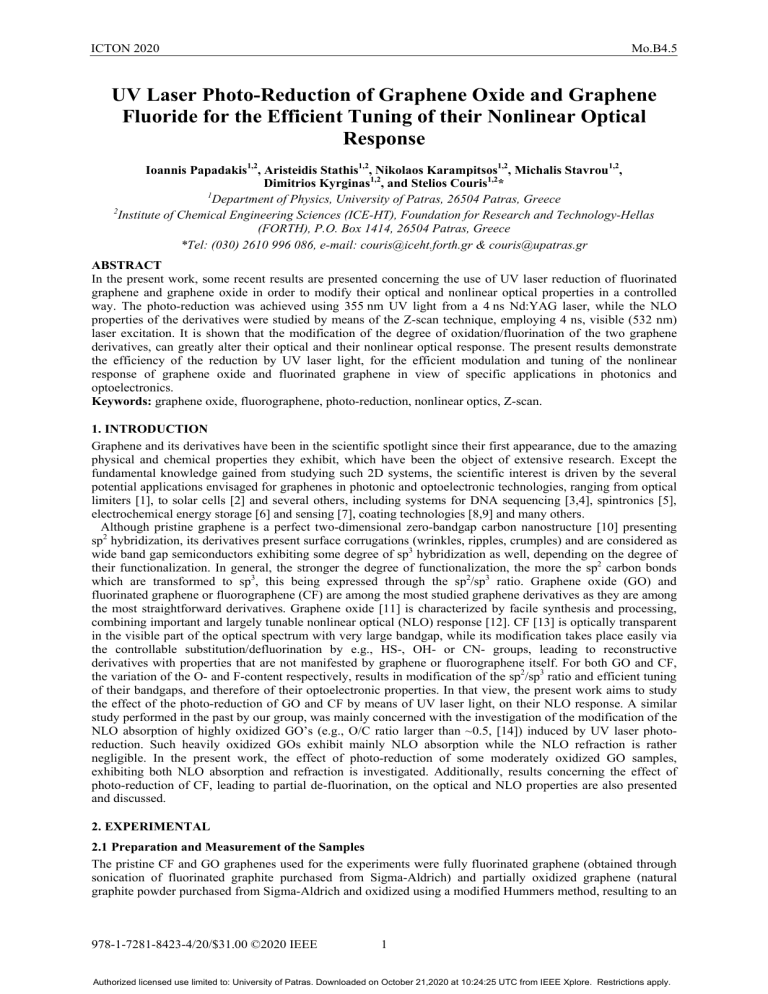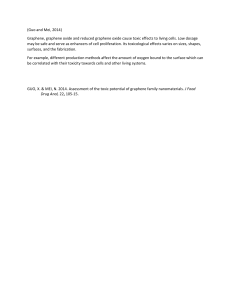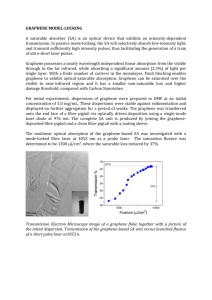UV Laser Reduction of Graphene for Nonlinear Optics Tuning
advertisement

ICTON 2020 Mo.B4.5 UV Laser Photo-Reduction of Graphene Oxide and Graphene Fluoride for the Efficient Tuning of their Nonlinear Optical Response Ioannis Papadakis1,2, Aristeidis Stathis1,2, Nikolaos Karampitsos1,2, Michalis Stavrou1,2, Dimitrios Kyrginas1,2, and Stelios Couris1,2* 1 Department of Physics, University of Patras, 26504 Patras, Greece 2 Institute of Chemical Engineering Sciences (ICE-HT), Foundation for Research and Technology-Hellas (FORTH), P.O. Box 1414, 26504 Patras, Greece *Tel: (030) 2610 996 086, e-mail: couris@iceht.forth.gr & couris@upatras.gr ABSTRACT In the present work, some recent results are presented concerning the use of UV laser reduction of fluorinated graphene and graphene oxide in order to modify their optical and nonlinear optical properties in a controlled way. The photo-reduction was achieved using 355 nm UV light from a 4 ns Nd:YAG laser, while the NLO properties of the derivatives were studied by means of the Z-scan technique, employing 4 ns, visible (532 nm) laser excitation. It is shown that the modification of the degree of oxidation/fluorination of the two graphene derivatives, can greatly alter their optical and their nonlinear optical response. The present results demonstrate the efficiency of the reduction by UV laser light, for the efficient modulation and tuning of the nonlinear response of graphene oxide and fluorinated graphene in view of specific applications in photonics and optoelectronics. Keywords: graphene oxide, fluorographene, photo-reduction, nonlinear optics, Z-scan. 1. INTRODUCTION Graphene and its derivatives have been in the scientific spotlight since their first appearance, due to the amazing physical and chemical properties they exhibit, which have been the object of extensive research. Except the fundamental knowledge gained from studying such 2D systems, the scientific interest is driven by the several potential applications envisaged for graphenes in photonic and optoelectronic technologies, ranging from optical limiters [1], to solar cells [2] and several others, including systems for DNA sequencing [3,4], spintronics [5], electrochemical energy storage [6] and sensing [7], coating technologies [8,9] and many others. Although pristine graphene is a perfect two-dimensional zero-bandgap carbon nanostructure [10] presenting sp2 hybridization, its derivatives present surface corrugations (wrinkles, ripples, crumples) and are considered as wide band gap semiconductors exhibiting some degree of sp3 hybridization as well, depending on the degree of their functionalization. In general, the stronger the degree of functionalization, the more the sp2 carbon bonds which are transformed to sp3, this being expressed through the sp2/sp3 ratio. Graphene oxide (GO) and fluorinated graphene or fluorographene (CF) are among the most studied graphene derivatives as they are among the most straightforward derivatives. Graphene oxide [11] is characterized by facile synthesis and processing, combining important and largely tunable nonlinear optical (NLO) response [12]. CF [13] is optically transparent in the visible part of the optical spectrum with very large bandgap, while its modification takes place easily via the controllable substitution/defluorination by e.g., HS-, OH- or CN- groups, leading to reconstructive derivatives with properties that are not manifested by graphene or fluorographene itself. For both GO and CF, the variation of the O- and F-content respectively, results in modification of the sp2/sp3 ratio and efficient tuning of their bandgaps, and therefore of their optoelectronic properties. In that view, the present work aims to study the effect of the photo-reduction of GO and CF by means of UV laser light, on their NLO response. A similar study performed in the past by our group, was mainly concerned with the investigation of the modification of the NLO absorption of highly oxidized GO’s (e.g., O/C ratio larger than ~0.5, [14]) induced by UV laser photoreduction. Such heavily oxidized GOs exhibit mainly NLO absorption while the NLO refraction is rather negligible. In the present work, the effect of photo-reduction of some moderately oxidized GO samples, exhibiting both NLO absorption and refraction is investigated. Additionally, results concerning the effect of photo-reduction of CF, leading to partial de-fluorination, on the optical and NLO properties are also presented and discussed. 2. EXPERIMENTAL 2.1 Preparation and Measurement of the Samples The pristine CF and GO graphenes used for the experiments were fully fluorinated graphene (obtained through sonication of fluorinated graphite purchased from Sigma-Aldrich) and partially oxidized graphene (natural graphite powder purchased from Sigma-Aldrich and oxidized using a modified Hummers method, resulting to an 978-1-7281-8423-4/20/$31.00 ©2020 IEEE 1 Authorized licensed use limited to: University of Patras. Downloaded on October 21,2020 at 10:24:25 UTC from IEEE Xplore. Restrictions apply. ICTON 2020 Mo.B4.5 O/C ratio of 0.25). The oxygen and fluorine contents were verified by high resolution XPS. For the UV laser photo-reduction of the two graphenes and the Z-scan measurements performed for the determination of their NLO parameters, aqueous dispersions of GO were prepared, while CF was dispersed in dichloromethane (DMF). The samples’ dispersions were placed in 1 mm thick quartz cells. The samples’ photo-reduction was performed using the third harmonic of a 4 ns Nd:YAG laser, at 355 nm, which was collimated and slightly expanded to ensure homogeneous illumination. The laser energy was monitored by a calibrated joulemeter placed behind the cell. The samples were exposed to different duration irradiation cycles. In order to evaluate the effects of the induced photo-reduction on the studied CF and GO, the UV-Vis-NIR absorption spectra of the samples were regularly taken before and after each irradiation cycle, in order to monitor the variation of the absorbance of the samples as a function of the irradiation time, and to ensure that no photodegradation was occurring [14,15]. After each irradiation cycle, the NLO properties of the CF and GO dispersions were determined using the 532 nm, 4 ns output from a Q-switched Nd:YAG laser operating between 1-10 Hz [16]. The laser beam was focused using a 20 cm focal length plano-convex lens and the beam waist at the focal plane was measured to be 18 ȝm. It is useful to add, that pristine (unfunctionalized) graphene dispersions irradiated for one hour by the same UV laser radiation, but using much higher fluence than that used for the CF and GO samples’ irradiation, was found unaffected, its UV-Vis-NIR absorption spectrum exhibiting no changes, and its NLO response remaining also unaltered. This observation suggests that the UV irradiation does not affect pristine graphene, while it can reduce the CF and GO. 3. RESULTS & DISCUSSION 3.1 Effects of the Reduction on the UV-Vis-NIR Absorption Spectra and the Band Gap In Fig. 1, the UV-Vis-NIR absorption spectra of the CF and GO samples obtained after some irradiation cycles are presented. The effects of the photo-reduction on the spectra are easily observable. So, by increasing the total UV irradiation time, the absorbance of both CF and GO samples were found increasing gradually, at a different rate however (the CF samples exhibiting a much higher rate of increase that that of the GO samples). It should be noted that this result is in perfect agreement with previous reports concerning the effects of UV photo-reduction on the absorption spectra of CF and GO [14,15]. The CF sample was irradiated for 5-min cycles for a total time of 15 min using a laser fluence of 5 mJ/cm2. However, since the CF sample was a fully fluorinated graphene, the induced relative changes of the absorption spectra were more noticeable. So, an increase of about 45% was observed for the absorbance at 532 nm. Concerning the GO sample, it was irradiated for a total of 40 min, using a laser fluence of 13 mJ/cm2. Initially, it was irradiated for two 5-min cycles (i.e., 10 min total irradiation time) and then it was irradiated again for 30 more minutes in order to achieve a significant change of its absorption spectrum and the corresponding NLO response. Since the initial GO sample was only partially oxidized (i.e., with an O/C ratio of ~0.25) the relative changes of its absorption spectrum were not so pronounced, at least compared with CF. More precisely, a 15% increase of its absorbance value at 532 nm was found after photo-reduction. CF’s and GO’s absorbance values at 532 nm after each irradiation cycle are shown in Table 1. Figure 1. UV-Vis-NIR absorption spectra of the pristine and reduced (a) CF and (b) GO. The green arrow indicates the laser excitation wavelength (532 nm) where Z-scan measurements were performed. Then, the bandgaps of CF and GO were estimated using the Tauc plot method. Although the accuracy of this method can be limited, it provides a fast and easy way to obtain some useful estimation of the bandgap value. The obtained results are presented in Table 1. CF’s bandgap has been reported to be about 3 eV [17], whereas 2 Authorized licensed use limited to: University of Patras. Downloaded on October 21,2020 at 10:24:25 UTC from IEEE Xplore. Restrictions apply. ICTON 2020 Mo.B4.5 GO’s bandgap is reported to be around 4.5 eV [18]. So, the bandgap values of CF and GO reported in Table 1 are in relatively good agreement with the literature values. As can be seen, the UV photo-reduction of the samples led to monotonic decrease of their bandgap, as was expected, since as the irradiation time increases, the degree of oxidation/fluorination is decreasing as well. Table 1. Absorbance (at 532 nm) and direct band gap values of CF and GO as a function of the irradiation time. Total irradiation time (min) 0 5 10 15 40 CF’s Absorbance 0.158 0.207 0.257 0.289 - GO’s Absorbance 0.101 0.109 0.113 0.116 GO’s Eg (eV) 3.76 3.73 3.68 3.61 CF’s Eg (eV) 2.35 2.25 2.20 2.09 - 3.2 Effect of in situ Reduction on the NLO Response of CF and GO For the determination of the NLO parameters (i.e., the real part and the imaginary part of the third-order nonlinear susceptibility Ȥ(3)) of the samples, Z-scan measurements were performed employing different incident laser intensities. From the analysis of the experimental data the NLO parameters were determined for each graphene derivative and then the corresponding third-order nonlinear susceptibility Ȥ(3) was calculated. Table 2 summarizes the obtained results. To make comparisons easier, the values of the NLO parameters listed in the table refer to the same concentration of 1 mg/ml. Table 2. Third-order nonlinear optical parameters of CF and GO. Total irradiation time (min) 0 5 10 15 40 CF GO ImȤ(3) (×10-13 esu) ReȤ(3) (×10-13 esu) |Ȥ(3)| (×10-13 esu) ImȤ(3) (×10-13 esu) ReȤ(3) (×10-13 esu) |Ȥ(3)| (×10-13 esu) 367 ± 38 250 ± 23 175 ± 18 100 ± 10 - -2050 ± 210 -1708 ± 179 -1408 ± 138 -1158 ± 110 - 2083 ± 210 1725 ± 179 1417 ± 138 1167 ± 110 - 20 ± 2 37 ± 4 63 ± 6 121 ± 11 -91 ± 9 -112 ± 10 -140 ± 16 -294 ± 31 93 ± 9 118 ± 10 154 ± 16 318 ± 31 As can be seen from Table 2, both CF and GO were found to exhibit important NLO response. More specifically, both samples exhibited Reverse Saturable Absorption (RSA) (i.e., ImȤ(3) > 0) and self-defocusing behavior (i.e., ReȤ(3) < 0). The observed RSA can be understood considering the involvement of excited states which exhibit large absorption cross-section [19]. As a general remark, the CF was found exhibiting much stronger NLO response than the GO, being more than 20 times stronger. Albeit the photo-reduction affects both CF’s and GO’s NLO response, it does not affect them in the same way. As can be seen from Table 2, the increase of the total irradiation time led to a two-fold decrease of CF’s NLO response while GO’s NLO response was increased by a factor of 3. For the case of GO, the observed increase of the NLO response can be understood in terms of the extension of ʌ-conjugation, as indicated by the expected increase of the sp2 carbons arranged in nano-domains and the decrease of its band gap, in agreement with ref. [14]. On the other hand, the decrease of CF’s NLO response can be explained through the modification of the nature of the C-F bond as it is described in detail elsewhere [19,20]. Another interesting observation can be made by comparing the relative strength of the NLO absorption and refraction of each sample. In both cases, the nonlinear refraction was found to be stronger than the corresponding nonlinear absorption; regarding the case of pristine CF and GO, the ratio of NLO refraction versus the NLO absorption was found to be about 5 for both cases. However, it should be emphasized that the photo-reduction of each sample affects this ration in a different way. At the end of irradiation, this ratio increases and becomes larger than 10 for the case of CF, whereas for GO, the ratio decreases, attaining a value of about 2. As seen by the values of Table 2, in both cases, the NLO absorption of the samples is being more significantly affected than the NLO refraction by the UV irradiation. This modification of the relative strength between the NLO refraction and absorption through in situ photo-reduction of the samples can be used as an efficient tool to make CFs/GOs with custom made properties in view of specific optoelectronic applications. 4. CONCLUSIONS To summarize, it is shown that the optical and nonlinear optical properties of fluorographene and graphene oxide can be efficiently tuned through in situ UV irradiation, which causes a mild reduction while leaving the material’s structure intact, e.g., the creation of C vacancy clusters is avoided. The photo-reduction led to the 3 Authorized licensed use limited to: University of Patras. Downloaded on October 21,2020 at 10:24:25 UTC from IEEE Xplore. Restrictions apply. ICTON 2020 Mo.B4.5 increase of the materials’ absorbance throughout the UV-Vis-NIR spectrum and the modification of their NLO properties. For the case of CF, its absorbance was increased by 45% and its NLO response was decreased by a factor of 2. Correspondingly, GO’s absorbance was increased by 15%, while its NLO response exhibited a 3-fold increase. Therefore, it can be safely concluded that UV irradiation can be an efficient tool for the in situ and controllable modification of the optical and NLO properties of these graphene derivatives. ACKNOWLEDGEMENTS The partial support of this work by "HELLAS-CH (MIS 5002735) implemented under “Action for Strengthening Research and Innovation Infrastructures,” funded by the Operational Programme” Competitiveness, Entrepreneurship and Innovation” (NSRF 2014-2020) and co-financed by Greece and the European Union (European Regional Development Fund) is acknowledged. I.P. acknowledges support from the Hellenic Foundation for Research and Innovation (HFRI) under the HFRI PhD Fellowship grant (Number: 80997). REFERENCES [1] Y. Sun et al.: Organic and inorganic optical limiting materials. From fullerenes to nanoparticles, Int. Rev. Phys. Chem., vol. 18, no. 1, p. 43, Nov. 1999. [2] V. Yong et al.: Theoretical efficiency of nanostructured graphene-based photovoltaics, Small, vol. 6, no. 2, p. 313, Jan. 2010. [3] S. Min et al.: Fast DNA sequencing with a graphene-based nanochannel device, Nat. Nanotechnol., vol. 6, p. 162, Feb. 2011. [4] S. J. Heerema et al.: Graphene nanodevices for DNA sequencing, Nat. Nanotechnol., vol. 11, p. 127, Feb. 2016. [5] W. Han et al.: Graphene spintronics. Nat. Nanotechnol., vol. 9 p. 794, Oct. 2014. [6] R. Raccichini et al.: The role of graphene for electrochemical energy storage, Nat. Mater., vol. 14 p. 271, Dec. 2015. [7] V. Urbanová et al.: Thiofluorographene-hydrophilic graphene derivative with semiconducting and genosensing properties, Adv. Mater., vol. 27, no. 14, p. 2305, Feb. 2015. [8] J. Rafiee et al.: Wetting transparency of graphene, Nat. Mater., vol. 11, p. 217, Jan. 2012. [9] B. Wang et al.: Graphene coatings as barrier layers to prevent the water-induced corrosion of silicate glass, ACS Nano, vol. 10, no. 11, p. 9794, Oct. 2016. [10] K. S. Novoselov et al.: Electric field effect in atomically thin carbon films, Science, vol. 306, no. 5696, p. 666, Oct. 2004. [11] D. Chen et al.: Graphene oxide: Preparation, functionalization, and electrochemical applications, Chem. Rev., vol. 112, no. 11, p. 6027, Aug. 2012. [12] X.-F. Jiang et al.: Graphene oxides as tunable broadband nonlinear optical materials for femtosecond laser pulses, J. Phys. Chem. Lett., vol. 3, no. 6, p. 785, Mar. 2012. [13] D. D. Chronopoulos et al.: Chemistry, properties, and applications of fluorographene, Appl. Mater. Today, vol. 9, p. 60, Dec. 2017. [14] N. Liaros et al.: The effect of the degree of oxidation on broadband nonlinear absorption and ferromagnetic ordering in graphene oxide, Nanoscale, vol. 8, no. 5, p. 2908, Jan. 2016. [15] M. Ren et al.: Reduction and transformation of fluorinated graphene induced by ultraviolet irradiation, Phys. Chem. Chem. Phys., vol. 17, no. 37, p. 24056, Aug. 2015. [16] M. Sheik-Bahae et al.: Sensitive measurement of optical nonlinearities using a single beam, Quantum Electron. IEEE J., vol. 26, no. 4, p. 760, Apr. 1990. [17] Ȃ. Pumera et al.: Towards stoichiometric analogues of graphene: Graphane, fluorographene, graphol, graphene acid and others, Chem. Soc. Rev., vol. 46, no. 15, p. 4450, May 2017. [18] M. A. Velasco-Soto et al.: Selective band gap manipulation of graphene oxide by its reduction with mild reagents, Carbon, vol. 93, p. 967, Nov. 2015. [19] I. Papadakis et al.: Dramatic enhancement of the nonlinear optical response of hydrogenated fluorographene: The effect of midgap states, J. Phys. Chem. C, vol. 122, no. 44, p. 25573, Oct. 2018. [20] I. Papadakis et al.: Hydrogenated fluorographene: A 2D counterpart of graphene with enhanced nonlinear optical properties, J. Phys. Chem. C, vol. 121, no. 40, p. 22567, Sep. 2017. 4 Authorized licensed use limited to: University of Patras. Downloaded on October 21,2020 at 10:24:25 UTC from IEEE Xplore. Restrictions apply.




